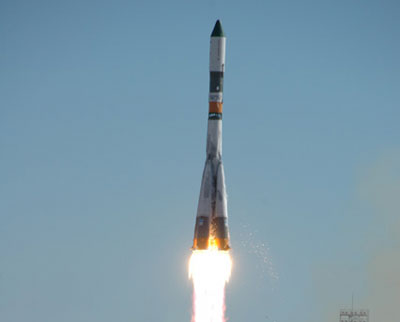Exploration and annihilation: a sobering anniversaryby Taylor Dinerman
|
| The great irony is that the early generation of ICBMs turned out to be much more effective as space launch vehicles than as weapons of war. |
Equipped with a nuclear warhead the Soviet ICBM had the capability, at least theoretically, of “winning” World War Three. In had the potential to negate the huge US investment in the Strategic Air Command’s (SAC) bomber fleet. The US was able to reduce this potential by keeping a few bombers in the air at all times and by keeping a large number of others on alert, but even so the comfortable superiority that the US had enjoyed before 1957 was gone for good.
It became apparent to everyone that the long-range nuclear-armed missile was now the ultimate weapon. Turning these rockets into effective weapons systems was not easy. The R-7, powered by liquid oxygen and kerosene, was not ideal. It took on the order of ten hours to fuel. According to Siddiqi, only three launch complexes were ever built and those did not become operational until 1960. By that time, the US not only had its own Atlas ICBMs in place, but had deployed the first Polaris missile submarines as well.
Yet the impact of Sputnik was so powerful that it was easy for the Soviet leader Khrushchev to claim that they were build rockets “like sausages”. It was also easy for John F. Kennedy and the Democrats to make the political case that the Eisenhower administration had allowed the US to fall behind in the missile race. It was these false statements, which were made in spite of the evidence from the U-2 overflights and from the first successful spy satellite missions that showed that how far behind the USSR was, that helped trigger Ike’s famous warning about the military industrial complex.
The great irony is that the early generation of ICBMs turned out to be much more effective as space launch vehicles than as weapons of war. Today the R-7’s direct descendant, the Soyuz launch vehicle, is still in operation and will soon gain new capabilities when a new pad in French Guiana is ready. Likewise, a version of the American Atlas, which was the first US ICBM to reach operational status, is still sending satellites into orbit.
As time went on, improved ICBMs became more accurate and could be fired on command. The solid-fueled Minuteman missiles achieved operational status in the mid-1960s and became the core of America’s land-based force. Today there are plans to refurbish at least 500 of them. Elements of others are being used in space launch vehicles such as the Minotaur.
The Russians are also successfully using parts of their older weapons as satellite launch vehicles. Today these are probably the lowest cost way for anyone to get into space. The Bigelow Aerospace Genesis modules that are now in orbit and are paving the way for a future privately-owned orbital facility were launched by converted SS-18 missiles. At some point the supply of these older systems will run out and it will be interesting to see if the US and the Russians find ways to civilianize parts of their ongoing missile programs.
| It would be amusing to see one irony piled on another if the first successful RLV looked just like an ICBM. |
The Orbital Sciences Corporation’s Taurus uses the Castor stage from the Peacekeeper missile. This has not been a best-selling way to get into space, to put it mildly. Will Russia find a way to sell rides into space using parts of their Topol/Bulova missile? They could certainly afford to sell their services for bargain prices but they may not want to undermine their other launchers and they may be uncomfortable providing insurance companies with reliable data on these systems. If they do turn the Topol into a launcher it may end up being for their own military use only.
Replacing ICBM-derived space launch vehicles with fully reusable systems (RLVs) has proven harder than almost anyone expected. There have been several aborted programs such as the National Aerospace Plane, the DC-X, the X-33, and others that did not even get as far as these. The mass fraction problem—the need to for the vehicle to have over 90% of its weight in fuel on takeoff—has so far been impossible to overcome.
This does not mean that an operational RLV is impossible. The step-by-step approach that some DC-X supporters proposed is probably the best way to proceed. “Build a little, fly a little, test a little, and repeat” may be too slow to match political expectations, but if properly managed it could be the right way to achieve the goal.
Meanwhile technology is improving and the efficiency of all types of launch vehicles will change with it. New health monitoring systems on the Space Shuttle Main Engines will be adapted to future rocket engines and new materials will make for lighter and more robust structures.
The SpaceX Falcon series looks, at first glance like a conventional launch vehicle, yet it has a recoverable and reusable first stage. It would be amusing to see one irony piled on another if the first successful RLV looked just like an ICBM.
We can all be thankful for the fact that so far, after fifty years, not a single nuclear tipped ICBM has been fired in anger. That is no excuse for complacency, for as they say in the TV ads, “Past performance is no guarantee of future results.”
